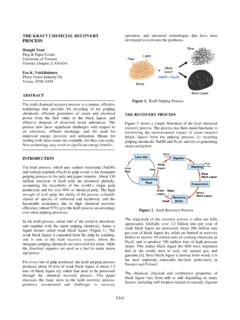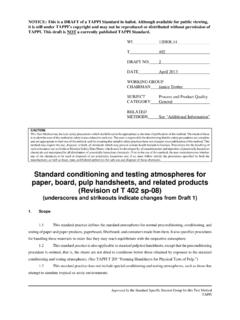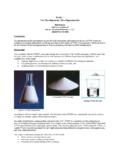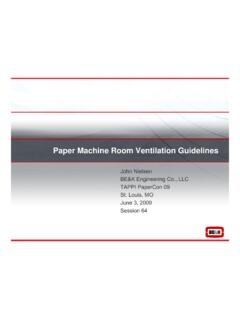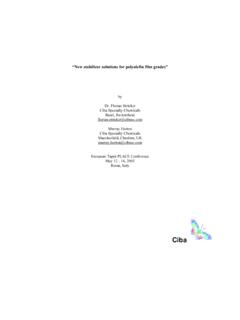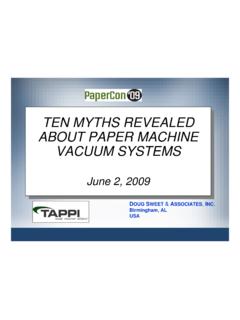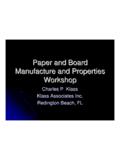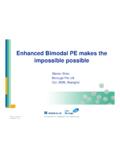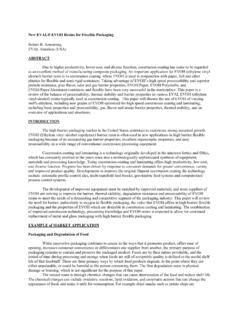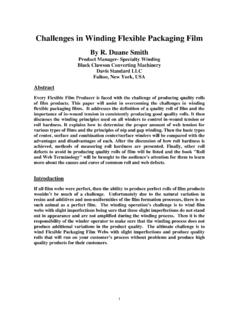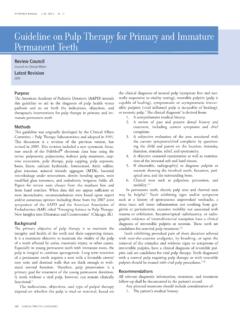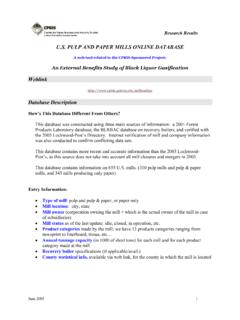Transcription of Water absorptiveness of sized (non-bibulous) paper ...
1 NOTICE: This is a DRAFT of a TAPPI Standard in ballot. Although available for public viewing, it is still under TAPPI s copyright and may not be reproduced or distributed without permission of TAPPI. This draft is NOT a currently published TAPPI Standard. WI T 441 DRAFT NO. 2 DATE Spring 2013 WORKING GROUP CHAIRMAN Ben Frank SUBJECT CATEGORY Physical Properties RELATED METHODS See Additional Information Approved by the Standard Specific Interest Group for this Test Method TAPPI CAUTION: This Test Method may include safety precautions which are believed to be appropriate at the time of publication of the method.
2 The intent of these is to alert the user of the method to safety issues related to such use. The user is responsible for determining that the safety precautions are complete and are appropriate to their use of the method, and for ensuring that suitable safety practices have not changed since publication of the method. This method may require the use, disposal, or both, of chemicals which may present serious health hazards to humans. Procedures for the handling of such substances are set forth on Material Safety Data Sheets which must be developed by all manufacturers and importers of potentially hazardous chemicals and maintained by all distributors of potentially hazardous chemicals. Prior to the use of this method, the user must determine whether any of the chemicals to be used or disposed of are potentially hazardous and, if so, must follow strictly the procedures specified by both the manufacturer, as well as local, state, and federal authorities for safe use and disposal of these chemicals.
3 Water absorptiveness of sized (non-bibulous) paper , paperboard, and corrugated fiberboard (Cobb test) (Proposed revision of T 441 om-09) (underscores and strikeouts indicate changes form Draft 1) 1. Scope This method describes a procedure for determining the quantity of Water absorbed by nonbibulous paper , paperboard, and corrugated fiberboard in a specified time under standardized conditions. It is based on studies by Cobb and Lowe (1), Cobb (2) and other investigators (3, 4). For testing unsized and absorbent paper , or paperboard, see TAPPI T 432 Water Absorbency of Bibulous paper . T 441 om-09 Water absorptiveness of sized (non-bibulous) paper , / 2 paperboard, and corrugated fiberboard (Cobb test) 2. Significance Water absorptiveness is a function of various characteristics of paper or board such as sizing, porosity, etc. This method is generally applicable to sized paper , paperboard and corrugated fiberboard, but it is not recommended as a sizing test for writing paper .
4 3. Definitions Water absorptiveness (Cobb value), the mass of Water absorbed in a specific time by 1 square meter ( square feet) of paper , board, or corrugated fiberboard under 1 cm of Water . 4. Apparatus Water absorption apparatus1, a device that permits one side of the specimen to be wetted uniformly at the moment the soaking period begins, and to allow controlled rapid removal of the Water from the specimen at the end of the test period. The specimen holder as shown in Fig. 1 comprises a metal ring with a machined lower face, cm ( in.) inside diameter (corresponding to a cross-sectional area of 100 cm2 ( )), cm (1 in.) high and about cm ( in.) thick, clamped to a flat base plate of the same or bigger size. On the base plate is a rubber mat, larger than the outside dimensions of the ring, on which the specimen is clamped. NOTE 1: The metal parts should preferably be a brass or other corrosion-resistant material.
5 NOTE 2: Several versions of the Water absorption apparatus are now available. Some use different ring sizes that fit in the same clamping fixture and some use different clamping methods. A change in clamping method may affect the speed at which the sample can be removed from the apparatus. It has been reported that spring loaded clamps may reduce leakage when testing corrugated fiberboard. Metal roller, solid brass, stainless steel or other corrosion-resistant material, having a smooth face 20 cm wide and weighing kg (22 lb). Timer, stopwatch or electric timer reading in seconds. Graduated cylinder, 100 mL. Balance, with an accuracy of g, or better. 1 Names of suppliers of testing equipment and materials for this method may be found on the Test Equipment Suppliers list, available as part of the CD or printed set of Standards, or on the TAPPI website general Standards page.
6 3 / Water absorptiveness of sized (non-bibulous) paper , T 441 om-09 paperboard, and corrugated fiberboard (Cobb test) Fig. 1. Specimen holder. 5. Materials Blotting paper1, sheets of standard blotting paper , 200 mm square, weighing 250 10 g/m2 (AD) in accordance with TAPPI T 410, a thickness of to mm in accordance with TAPPI T 411, and having a minimum rate of absorbency of 25 mL of Water when tested in accordance with TAPPI T 432 Water Absorbency of Bibulous paper . The wet expansion shall not exceed in the cross direction following the specification of TAPPI T 205. The blotters shall be white, produced from fully bleached chemical pulp free of any additives. They shall be flat, uniform, and free of wrinkles and dirt. 200-250 g/m2 (123 - 154 lb/3000 ft2), with a capillary rise of 50 100 mm (2 - 4 in.) of Water (mean of MD + CD) as measured by the Klemm method (ISO 8787). Normally, the blotter specified in TAPPI T 205 Forming Handsheets for Physical Tests of pulp will meet this requirement.
7 Blotting paper should not be used for more than one test, as the absorptive nature of the material changes once it has been exposed to Water during the first use. Water , distilled (pure) or deionized. T 441 om-09 Water absorptiveness of sized (non-bibulous) paper , / 4 paperboard, and corrugated fiberboard (Cobb test) 6. Sampling and test specimens If a lot of paper is being tested to determine whether it meets specifications, obtain a sample of the paper in accordance with TAPPI T 400 Sampling and Accepting a Single Lot of paper , Paperboard, Containerboard, or Related Product. From each test unit, cut specimens to a size slightly greater than the outside dimensions of the ring of the apparatus, , squares cm ( in.). The specimens should be free from folds, wrinkles, or other blemishes not commonly inherent in the paper . The standard test area is 100 cm2. If the available specimens are too small, a proportionately smaller test area may be used providing that the volume of Water is reduced to provide a pressure head of 1 cm.
8 Other common test areas include 25 cm2 and 10 cm2. A change in area from 100 cm2 should be noted in the report. While Cobb absorptivity is often considered a bulk property, some materials may have different absorptive properties from each side (felt or wire). Sample enough material so that complete testing can be performed on one or both sides of the paper to be evaluated. Specimens tested on one side cannot be reused for evaluation of the properties of the other side. For hard- sized papers (absorbing less than 100 g of Water /m2 ( ft2)), use 5 specimens per side. For soft- sized papers, absorbing more than 100 g/m2 ( ft2), use 10 specimens per side. For corrugated fiberboard at least five tests should be carried out on the outside (double back) liner. United Nations and United States regulations for the shipment of hazardous materials specify a 30-min Cobb test for the outer surface (double back liner) of corrugated board.
9 Five tests are required on the outer surface. When testing for compliance for the shipment of hazardous materials the user is advised to refer to specific standards for additional information. 7. Procedure Precondition and condition the specimens in an atmosphere in accordance with TAPPI T 402 Standard Conditioning and Testing Atmospheres for paper , pulp Handsheets, and Related Products. Weigh each specimen to the nearest g. Place a dry rubber mat on the metal plate and lay a weighed specimen on it. After wiping the metal ring, dry (do not use heat), place it upon the specimen, and fasten it firmly enough in place with the crossbar (or other clamping mechanism) to prevent any leakage between the ring and the specimen. For materials where leakage between the ring and the upper surface of the test specimen may occur during the test, a soft elastic non-absorbent gasket may be used. The gasket should have the same internal dimensions as the ring.
10 5 / Water absorptiveness of sized (non-bibulous) paper , T 441 om-09 paperboard, and corrugated fiberboard (Cobb test) NOTE 3: On corrugated fiberboard, some users have overcome leakage by either removing the flutes from the back of a sample or by crushing the flutes prior to testing. The former approach has been shown in round robin studies to impact (reduce) test results and is not recommended. See Pour 100 mL of Water (23 1 C ( F)) into the ring as rapidly as possible thus giving a head of cm ( in.). Start the stopwatch immediately. At 10 2 s before the expiration of the predetermined test period, usually 120 s for paper or 1800 s for combined board, pour the Water quickly from the ring, taking great care not to drip any of the Water upon the outside portion of the specimen. Promptly loosen the wing nuts (or other applicable clamping mechanism), and swing the crossbar out of the way while holding the ring in position by pressing it down with one hand.
